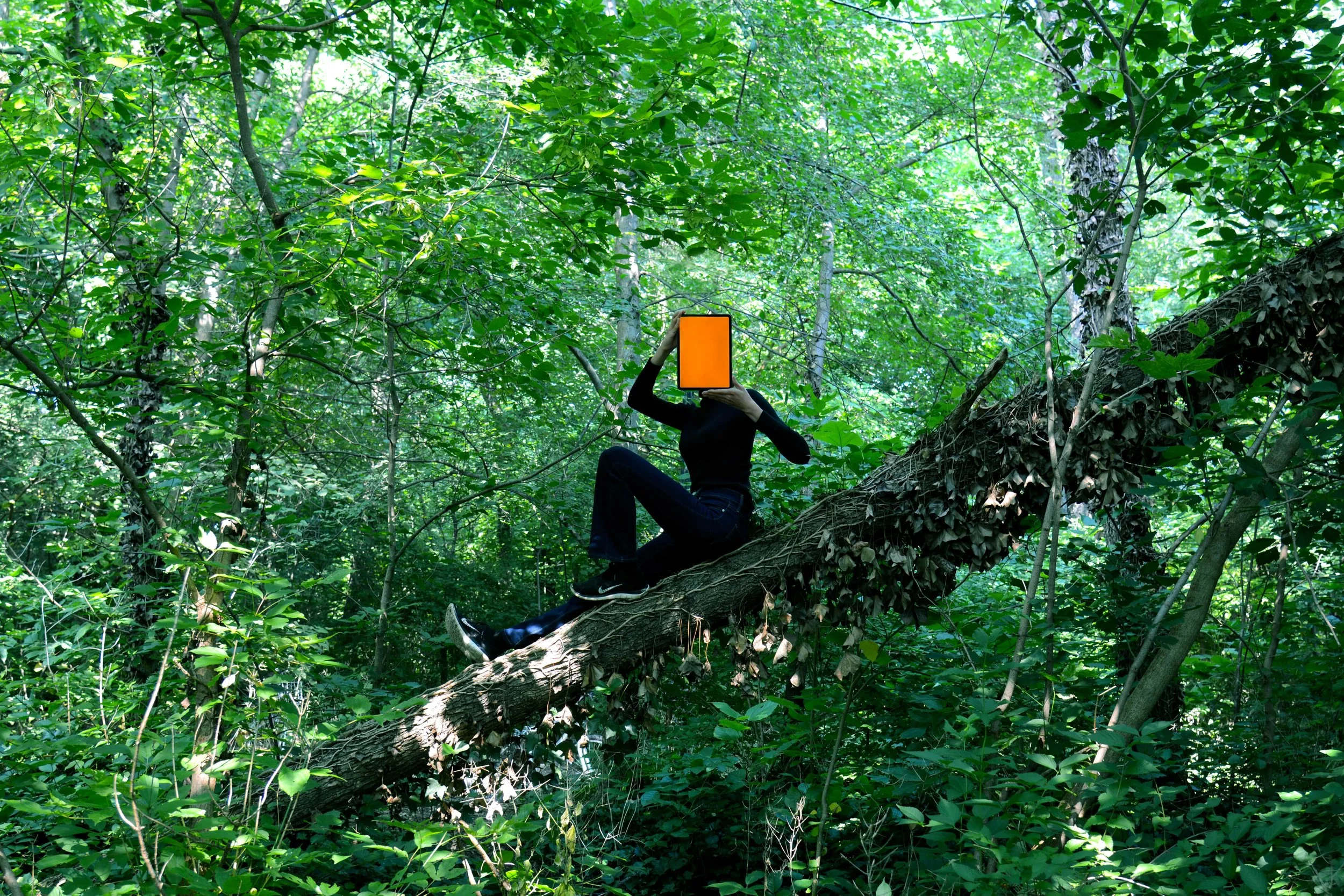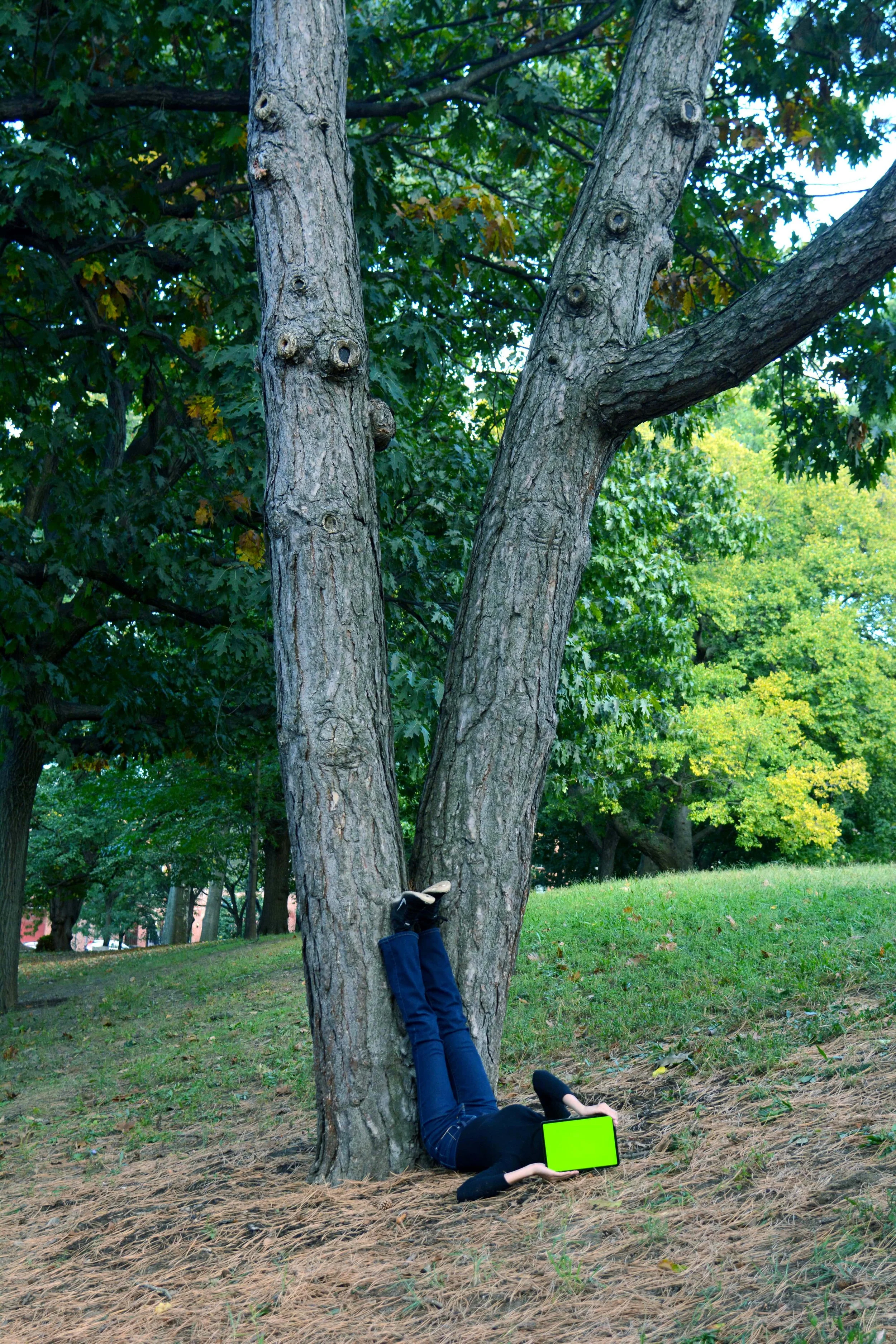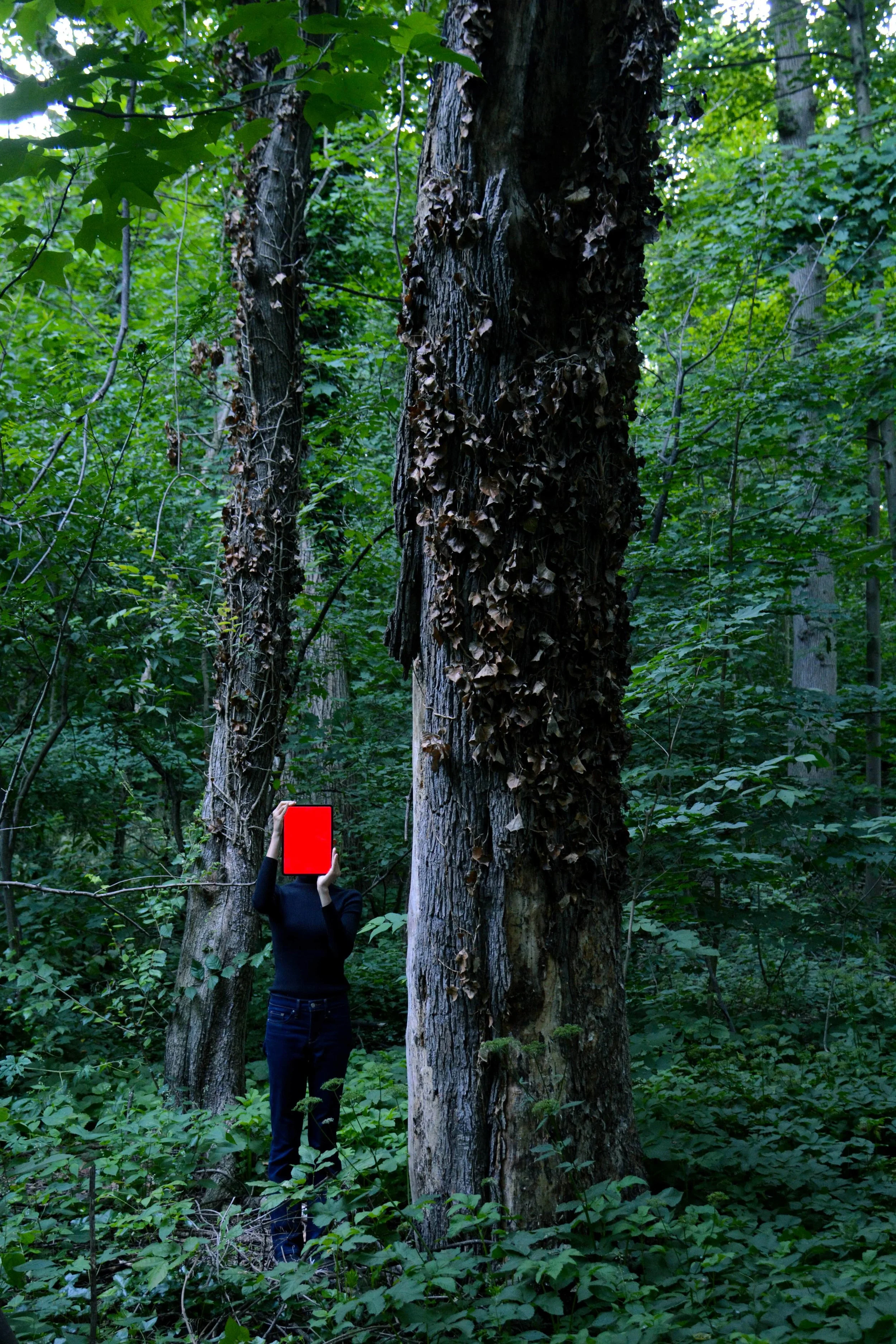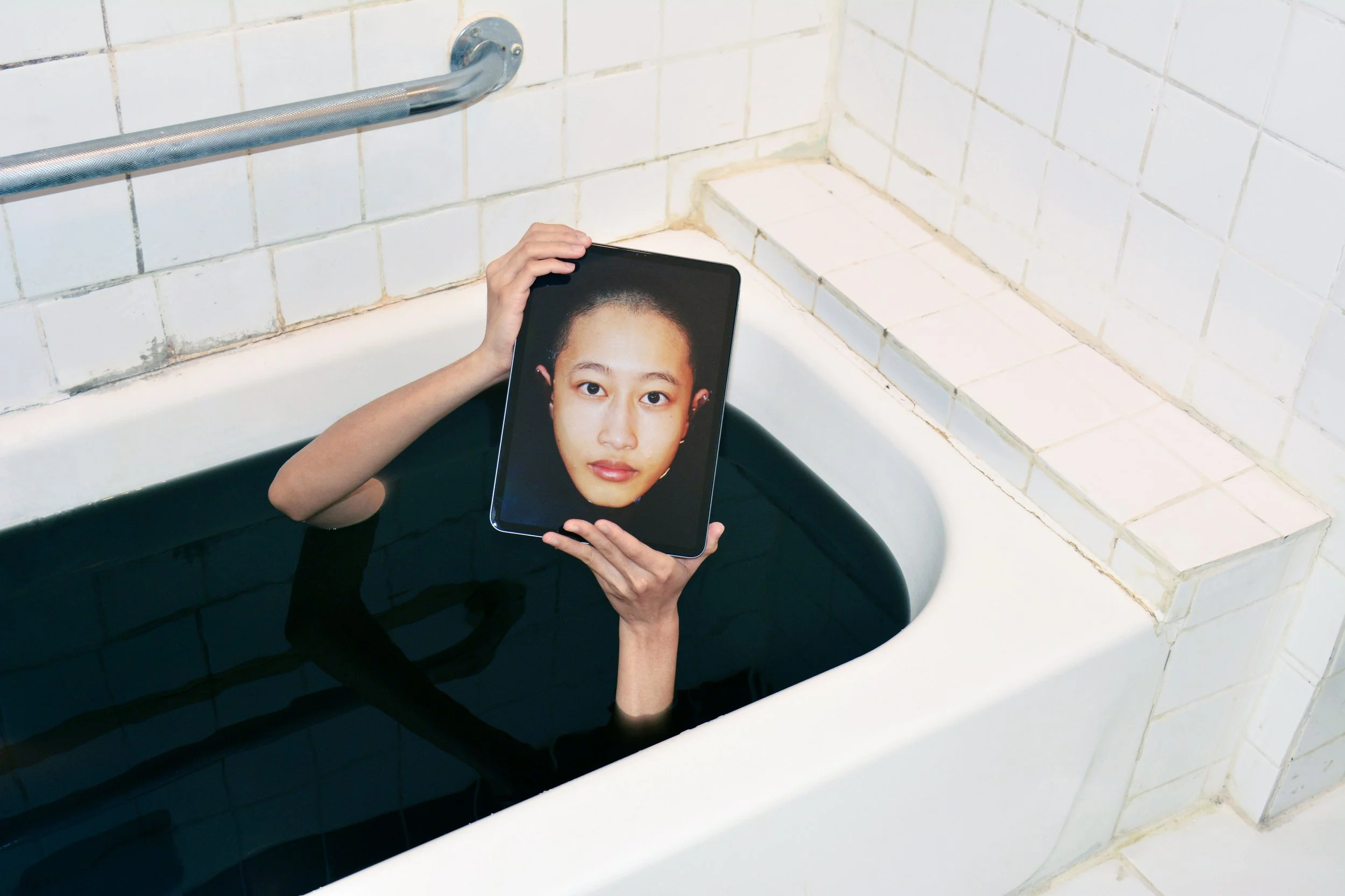Entung Liu

"The screen represents the essential, yet rapidly dissolving, boundary between the physical self and the digital framework of contemporary culture."
Entung Liu is an interdisciplinary artist whose performance-led practice examines the shifting boundaries between the body, technology, and digital culture. In this interview, Liu discusses the role of the body as a communicative medium, the cultural force of screens, and how transformation shapes both her performances and her critique of contemporary life.
Could you tell us a bit about yourself and your background?
I was born in 1995 in Taipei, Taiwan. As an interdisciplinary artist, my work explores the intersection of visual art, performance, and technology through various methods, including performance, photography, videos, installations, paintings, and sound. I received a BFA in Multimedia Art from Taipei National University of the Arts in 2018 and an MPS in Interactive Telecommunications Program from New York University in 2022. My artistic vision is rooted in transforming the absurdity of daily existence into a transparent mirror, reflecting the invisible social issues hidden beneath the fantasy of technology. Drawing on my interdisciplinary background, my creative process establishes an intensive connection between the body and space. This practice is keenly focused on how corporeal gestures and the resulting shifts in eyesight can disrupt and shift public awareness. The execution of this vision occurs through dedicated multimedia practices and collaborative participatory theater, operating on the belief that 'Daily life is a theater, and the theater is life.’ Participation is employed as a compelling method to unfold static social structures and reimagine the existing world. Through these immersive actions, my practice ultimately seeks to reveal the complex relationships between body, identification, technology, nature, and life.
Performance is central to your practice, often unfolding in public or everyday spaces. What draws you to use the body as your main medium, and how does performing in these open environments influence your work?
The body is my most direct medium for genuine communication and connection. It is simultaneously durable and fragile, making performance an act of self-exposure where I can shed daily masks and escape the controlled world. Conceptually, my practice emphasizes the relevance of the organic form in contrast to the pervasive drive of technology. When AI and ideas of brain duplication promise immortality or a body-less existence, I find this ideology of the unlimited to be dangerous. The body's limitations—its vulnerability and inevitable process of decay—are precisely what create value and lead us to cherish. This conceptual focus extends to the environment. The uniqueness of open environments—their historical context, original functions, traces of activity, and the people on site—is a critical stage setting for my performances. There are visible and invisible rules in every public space that reveal existing social structures, and I enjoy playing with them. I invite participants to observe, listen to, and interact with the environment in unexpected ways, and to rediscover it through the process. The boundary of a space also influences my work, and it is like a collaborator, with whom I like to learn from and respect via my body and performance.
Too Bright To Be Painful - #FF8000-2, 2022-2025
Too Bright To Be Painful - #80FF00-2, 2022-2025
Too Bright To Be Painful - #FF0000-2, 2022-2025
Screens appear in a couple of your projects, sometimes replacing or framing the body. What do you think screens represent in our culture today, and how do you use them to question how we see and present ourselves?
It is an insightful question that gets to the core of my current practice. The screen represents the essential, yet rapidly dissolving, boundary between the physical self and the digital framework of contemporary culture. I grew up witnessing the evolution of screens, from the bulky, weighty "body" of the early television to the invisible, potentially implanted interfaces of the future. This technological trajectory—the loss of the screen's physical mass—parallels its increasing cultural omnipresence, making it an unseen, inescapable medium. In my work, where screens literally frame or replace the body, I question this invisibility. The screen is not just glass; it is a powerful apparatus driven by algorithms, data, and AI. This ecosystem often disguises profit-driven bias as reality, creating a distorted spectacle. This tool, rather than solely addressing human issues, frequently magnifies social bias. By using the screen, I explore the contemporary dilemma: How do we present an authentic self when we are constantly performing for, and being viewed by, both others and the algorithms? The screen forces us into a state of dual consciousness—we become both the performer and the viewer of our own identity, making daily existence a continuous act of digital performances.
In several of your performances, the body is transformed through surface and gesture, creating a striking sense of distance and abstraction. What role does transformation play in your work?
Transformation is a crucial lens for viewing my work, acting both as an internal mechanism for discovery and an external critique of digital culture. In the series of works <Too Bright To Be Painful>, transformation begins with the body's gesture. I apply the mimicry of animals, making the human form appear unusual, to explore the profound relationship between humanity and the natural world. This internal, embodied shift, driven by the focus on non-human movement, heightens my sensory engagement with the environment, allowing me to perceive small details often neglected by a typical visitor. The abstraction and distance viewers recognize is vital for the conceptual subject: the digital transformation of the body itself. The work critiques how easily efforts and emotional nuances become erased when the body is rendered as a clean, bright digital signal on a screen. By maintaining stable, seemingly comfortable gestures that actually require intense effort to hold, I pose a question to the viewer: How painless is it to consume information on your screens? This transformation highlights the danger of passive consumption, restoring the felt quality of pain and effort into the supposedly smooth digital image.
A Daily Theater, 2022
A Daily Theater, 2022
I Am Where I Am, 2021
Tell us a bit about how you spend your day / studio routine? What is your studio like?
My creative process is fully integrated with my daily life, operating around a highly flexible routine. Since most of my art is performance-based with digital recordings, I don't require a traditional studio space, which allows for immense mobility and adaptability. I dedicate weekdays to the necessary conceptual and administrative groundwork. Before and after my 9-to-5, I focus on critical tasks, including editing video and photographic content, organizing digital assets, writing for applications and grants, and planning for upcoming exhibitions and performances. I also keep a notebook close at hand in my office to quickly capture ideas and inspiration. The intensive execution, which includes performing and recording, is strategically scheduled for the weekends. It allows me to have uninterrupted blocks of focused creative time. My current "studio" is a minimal and flexible living space. I prioritize highly movable furniture, allowing me to easily transform the environment into a temporary workshop for painting, rehearsing, and building installations. This fluid approach keeps my practice dynamic and fresh, and I enjoy it for now. However, if I need a permanent studio space in the future, I still want to have a designed studio at home where I can fully immerse myself in creative activities.
What artwork have you seen recently that has resonated with you?
I have recently been re-exploring the work of pioneering performance artists, including Francis Alÿs, Tehching Hsieh, and Ana Mendieta. Mendieta's <Silueta Series> has deeply resonated with me. These ephemeral, earth-body works—female silhouettes created in natural landscapes using materials like mud, sand, or flowers—explore powerful themes of identity, violence, and the spiritual connection between the body and the earth. Inspired by Mendieta's approach to traces and imprints in nature, I began to investigate what a body’s physical printing on technology truly entails, and how the relationship between the human and natural world is shifting in the digital age. This led me to the concept of the "Body of Technology." While technology is often perceived as cold, intangible, and inanimate, I aim to challenge this by deliberately foregrounding its sensory and material experience. I invite participants and viewers to engage with technology through its often-neglected, bodily qualities: vibration, materiality, temperature, sound, taste, and smell. By prompting this imagination of a technological body, I subvert existing digital narratives and advocate for a necessary re-embodiment of the contemporary digital era, urging a new way to connect with the mediators that shape our lives.
Is there anything new and exciting in the pipeline you would like to tell us about?
Lately, I have been working on a new project called <Existing in You>, which explores immigrant identity by combining field research, photography, performance, and AI. The project was inspired by my personal experience navigating the U.S. visa system. Last year, despite submitting all required documents on time, my H-1B application was denied without a clear explanation. The unlawful process led me to sue USCIS for procedural errors; after six months, I finally received my visa. While the outcome was positive, the experience left me questioning the role of bureaucracy and technology in shaping the lives of immigrants. Did anyone actually read my 100-page submission, or was it skimmed—or even processed—by AI? How does a state apparatus distinguish between a “real” person and an AI-generated identity? These reflections became the foundation of <Existing in You>. I plan to start presenting the project in 2026. For those interested, welcome to find new updates on my website and Instagram. Additionally, my work, <I Am Where I Am>, is currently on view as part of the exhibition 'Dislocated,' presented by Midwest Nice Art. Feel free to take a look!
All images courtesy of the artist
Interview publish date: 20/11/2025
Interview by Richard Starbuck





